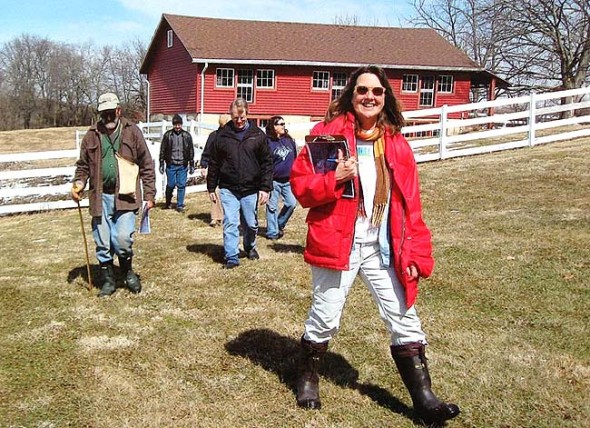
Tecumseh Land Trust Executive Director Krista Magaw leads a hike on one of the numerous properties for which the trust has helped secure a conservation easement. The trust is working to purchase up to 10 properties this year and is hoping to solicit donations and new members to help with the operating costs associated with the process. (Submitted Photo)
Tecumseh Land Trust hopes to secure 10 farms
- Published: April 21, 2016
The Tecumseh Land Trust, or TLT, is working to secure easements for 10 family farms within the year. As it happens, the landowners’ interest in placing easements on the land coincides with an opportunity to take advantage of generous federal funds, according to executive director Krista Magaw.
“This is an opportunity we haven’t seen in over a decade,” stated Susan Miller, the land trust’s vice president, in a recent press release.
However, more easements means more staff time and more money required to manage the properties. Applications for preservation funds take hundreds of hours of staff time, Magaw said, which is why the trust launched a fund drive this month to help with its day-to-day expenses.
State and federal grants are used to purchase the easements, Magaw said, but almost none of that money goes to TLT’s $240,000 annual operating budget.
“Many people are not aware that almost all of the land trust’s day-to-day funding is from membership donations,” stated Miller in the press release.
To help with these expenses, the trust is hoping to increase donations from existing members and attract new members. Funding from the trust’s 500 current members pays for about 75 percent of TLT’s operating expenses, Magaw said.
The trust is currently able to take advantage of a federal program that would assist with the cost of the easement, matching the price with $9 for every $1 of state and local funds. (That 9:1 ratio reflects federal funds and the value of land the property owner is willing to donate.) That’s a lot of potential easements, she said, and a lot of land that can be preserved.
But timing is of the essence for a few reasons, Magaw said. While the trust has the opportunity to secure these matching funds for the next five years, conservation money is never a sure thing. The upcoming presidential election may determine how much money is earmarked for programs like land trusts and conservation, she said.
The pace of residential and commercial development has been steady, according to Magaw. While Ohio’s population has been relatively stable since the 1970s, land use has tripled.
“We have to weigh the use of land for development against its value as agricultural land, or land buffering water resources and their delicate ecosystems,” Magaw said.
The 10 new properties would add to the 25,000 acres of farmland, wetlands and streams protected by easements since the trust was founded in 1990. The easements help protect the integrity of water resources and farmland by preventing them from being parceled out for development, said Magaw.
She added that the trust’s longterm goal is to protect 50,000 acres in both Greene and Clark counties, or about 20 percent of the land in the counties. That level of preservation is needed to secure the agricultural viability of an area, and to maintain the industry associated with farming, such as equipment repair and grain storage facilities, she said.
The benefits of an easement are many, she said. Landowners benefit financially, natural resources are protected and everyone can enjoy the beautiful vistas and waterways preserved by the easement, she said.
In fact, said Magaw, conservation easements may even help keep taxes low in some situations, as land that remains undeveloped will not require extensive infrastructure such as sewer and roads, which is a cost borne by residents. Tax burden is a common problem faced by areas where development did not take off as expected — infrastructure still has to be maintained, and police often have to patrol abandoned buildings and strip malls.
The 10 parcels the trust is considering represent an “exceptional mix of woods, stream corridor and prime soils,” and are located within the Great and Little Miami watersheds. One issue the trust is currently focusing on is water quality, Magaw said, and the 10 properties they are considering include a significant amount of waterways.
Magaw maintains that if there weren’t organizations like TLT advocating for conservation easements, the work wouldn’t get done. The federal government will assist if asked, but the onus is on motivated groups and individuals to determine what happens to their lands.
“The Land Trust is important because we’re local, and our focus is forever,” Magaw said. “We’re here because people care enough about land conservation to become members.”
More information on Tecumseh Land Trust and its work can be found at http://www.tecumsehlandtrust.org, or by calling 767-9490.
Contact: dtaylor.lehman@ysnews.com
The Yellow Springs News encourages respectful discussion of this article.
You must login to post a comment.
Don't have a login? Register for a free YSNews.com account.













No comments yet for this article.